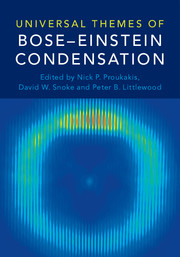Book contents
- Frontmatter
- Contents
- Foreword
- Preface
- Part I Introduction
- Part II General Topics
- Part III Condensates in Atomic Physics
- Editorial Notes
- 13 Probing and Controlling Strongly Correlated Quantum Many-Body Systems Using Ultracold Quantum Gases
- 14 Preparing and Probing Chern Bands with Cold Atoms
- 15 Bose-Einstein Condensates in Artificial Gauge Fields
- 16 Second Sound in Ultracold Atomic Gases
- 17 Quantum Turbulence in Atomic Bose-Einstein Condensates
- 18 Spinor-Dipolar Aspects of Bose-Einstein Condensation
- Part IV Condensates in Condensed Matter Physics
- Part V Condensates in Astrophysics and Cosmology
- Universal Bose-Einstein Condensation Workshop
- Contributors
- Index
- References
14 - Preparing and Probing Chern Bands with Cold Atoms
from Part III - Condensates in Atomic Physics
Published online by Cambridge University Press: 18 May 2017
- Frontmatter
- Contents
- Foreword
- Preface
- Part I Introduction
- Part II General Topics
- Part III Condensates in Atomic Physics
- Editorial Notes
- 13 Probing and Controlling Strongly Correlated Quantum Many-Body Systems Using Ultracold Quantum Gases
- 14 Preparing and Probing Chern Bands with Cold Atoms
- 15 Bose-Einstein Condensates in Artificial Gauge Fields
- 16 Second Sound in Ultracold Atomic Gases
- 17 Quantum Turbulence in Atomic Bose-Einstein Condensates
- 18 Spinor-Dipolar Aspects of Bose-Einstein Condensation
- Part IV Condensates in Condensed Matter Physics
- Part V Condensates in Astrophysics and Cosmology
- Universal Bose-Einstein Condensation Workshop
- Contributors
- Index
- References
Summary
The present chapter discusses methods by which topological Bloch bands can be prepared in cold-atom setups. Focusing on the case of Chern bands for two-dimensional systems, we describe how topological properties can be triggered by driving atomic gases, either by dressing internal levels with light or through time-periodic modulations. We illustrate these methods with concrete examples, and we discuss recent experiments where geometrical and topological band properties have been identified.
Introduction
Ultracold atoms constitute a promising physical platform for the preparation and exploration of novel states of matter [1, 2, 3]. In particular, the engineering of topological band structures with cold-atom systems, together with the capability of tuning interactions between the particles, opens an interesting route toward the realization of intriguing strongly correlated states with topological features, such as fractional topological insulators and quantum Hall liquids [4].
This chapter is dedicated to the preparation and the detection of topological band structures characterized by nonzero Chern numbers [5]. Such Chern bands, which constitute the building blocks for realizing (fractional) Chern insulators [6, 7], arise in two-dimensional (2D) systems presenting time-reversal-symmetry (TRS) breaking effects. For instance, nontrivial Chern bands naturally appear in the Harper-Hofstadter model [8], a lattice penetrated by a uniform flux, where they generalize the (nondispersive) Landau levels to the lattice framework. Additionally, Chern bands also appear in staggered flux configurations, such as in Haldane's honeycomb-lattice model [9] or in lattice systems combining Rashba spin-orbit coupling and Zeeman (exchange) fields.
The atoms being charge neutral, “magnetic” fluxes cannot be simply produced by subjecting optical lattices to “real” magnetic fields. It is the aim of this chapter to review several schemes that have been recently implemented in laboratories with the goal of realizing synthetic magnetic fields leading to Chern bands for cold atoms. Our presentation is complementary to that of Chapter 15, as we focus on synthetic magnetic fields in lattice-based systems for which the flux density can be made very large (with magnetic length comparable to interparticle spacing). The chapter is structured as follows: Section 14.2 describes how the Chern number is related to physical observables defined in a lattice framework. In particular, it clarifies the link between recent Chern-number measurements performed in cold bosonic gases and the more conventional (electronic) quantum Hall effect.
- Type
- Chapter
- Information
- Universal Themes of Bose-Einstein Condensation , pp. 274 - 298Publisher: Cambridge University PressPrint publication year: 2017

